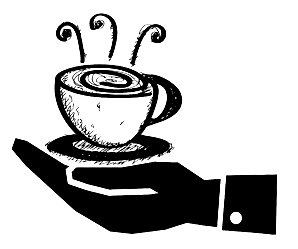By Megan Hannan
In this time of crisis, we all find ourselves needing comfort a little more than usual. Most of us have enough control over our lives that with a little effort we can create these moments of comfort, whether it’s attending a yoga class via video chat, having a phone conversation with our daughter, or even just sipping a quiet cup of coffee on the front porch to start our day. Our loved ones living in long-term care may not have the same means to find comfort. Those living with dementia have an even greater struggle, as they may not even be able to recognize their increased need, let alone identify a source of comfort and then work to attain it. In short, they lack the ability to self-comfort as we can.
How can we help, especially when we are physically separated from them? Talking over the phone or at a window can provide connection and reassurance, but these brief interactions cannot fill a day.
However, with careful forethought we can make those moments meaningful in ways that will continue bringing comfort for the person well after our conversation is over.
Following are tips for how to connect with your loved one to support their need for love, comfort, personal identity, purpose in life (occupation), inclusion, and personal connections with people and things (attachment) – the basic needs in life that we all share, according to dementia research pioneer, Thomas Kitwood.
Connect in ways that reinforce identity
- Does your loved one enjoy music? Often people living with dementia can recognize a song or instrumental, and even remember words and melody. You could sing over the phone together and bellow out your old favorites!
Or, send a recording of music or a link to an opera or jazz performance to play on an iPad or smart TV. When my mother was living, she listened over and over to a recording of my son singing opera. It was her grandchild, so it didn’t matter if it was of bad quality or that she couldn’t see him really well – she knew him, and she loved opera!
- Do you have photos or artwork at your home that belong or relate to your loved one? Consider compiling a small packet of photos or mementos to help the person reminisce – and be overjoyed to receive a gift! But first, check with the care home to ensure they allow items to be delivered during the pandemic.
Provide meaningful occupation with activity boxes and packets
Send items your loved one can rummage through or assemble when they are alone or interacting with you on the telephone or social media. Try to include things related to the sights, sounds, smells and tactile senses of their long-term memory. You might include:
- Greeting cards. Ask the person to pick out 10 of their favorites.
- Something that involves writing, an embedded skill that people with dementia often retain. You might send blank greeting cards on which your loved one can write thank-you notes or other messages to their caregivers.
- Send several skeins of yarn and ask their help winding them into balls.
- Write several letters or cards to the person, place each in a separate envelope and send them together in one big package. It will be fun for them to receive a package and find several things inside to open and read.
- Keep a look out for funny or interesting photos that you might print in large format and send in a packet. Or, take photos of artwork, animals, and children and include them.
- Create a nice, framed picture of a favorite prayer, poem, or quote to send to the person and when you call, read it together.
- Send a letter each day if you can. Just a nice card with a couple of words works wonders for a moment and can always be re-visited.
Make it purposeful
Think of activities you can provide and conversations you can have with your loved one that reinforce their feelings of self-worth and purpose in life. Their purpose could be:
- Familial: The entire family wants to connect with you – we can hardly wait until this is over and we can have a picnic!
- Religious: Please promise me you’ll pray for John, Dad. He’s still working in the grocery store and it’s so important – he is a hero –but he needs our prayers.
- Hobbies: I know you said you didn’t want to sew anymore, but would you be interested in cutting some of the pieces for these masks I’m making?
- Relationships: Mom, remember your old neighbor Jean? She’s feeling awfully lonely and I know she’d love to hear a friendly voice. I always enjoyed those stories about the trouble you two got into together as kids, maybe you could call her just to reminisce a bit?”
Or, ask your loved one to make a list of things that bring her joy and think of how we can make those things happen again.
Use phone, FaceTime, and Zoom to reinforce feelings of inclusion, personal connections, love
- Read aloud religious and spiritual passages, poems, and jokes.
- Make lists together – e.g., all the places you have visited, family members as far back as we can remember, spring flowers, books we’ve read.
- Think of what comforts or humors the person. Give simple reassurances: You are in a safe place and are helping others be safe by staying in your room.
- Ask not how she is doing, but how do you feel right now, Mom? And LISTEN – even if the person’s language is unclear, listen for emotions. Agree and say, I see, I understand how you feel.
- Share all that you are doing even though it may not seem like much: I’m cooking, reading, writing letters, working on the computer, calling and talking with other family members, weeding the garden for the first time in years (Ok, that’s what I’m doing.)
- Recall and reminisce about things you both love, like recipes, sports teams, or your children as babies.
- Don’t forget to say, I love you.
And remember – do ONE of these things on a call and save something else for another call.
Collaborate with staff
Do your loved one’s caregivers have suggestions? Is there a time of day that is harder than others? Can you do something to help at that time? What have they had success with to help the person calm down, relax, laugh, get distracted, and feel useful?
Finally, take care of yourself. People living with dementia may not understand about the pandemic, but they can sense when those around them are feeling anxious and upset. We can help bring them comfort only when we, ourselves, are comfortable. So, enjoy your daily pleasures and together we can get through this.





 During her work day as a registered dietitian at Brewster Village, Rikki Profant keeps a small brown notebook with her to jot down notes. It’s not a diary or journal of her own thoughts, but rather quotes and stories from residents she takes on bicycle rides via a newly introduced program aimed at getting the elderly occupants of the rehabilitation and nursing home back outdoors. She keeps the notebook “somewhat selfishly” to remember nuggets of wisdom, but more importantly, to recognize the impact that the
During her work day as a registered dietitian at Brewster Village, Rikki Profant keeps a small brown notebook with her to jot down notes. It’s not a diary or journal of her own thoughts, but rather quotes and stories from residents she takes on bicycle rides via a newly introduced program aimed at getting the elderly occupants of the rehabilitation and nursing home back outdoors. She keeps the notebook “somewhat selfishly” to remember nuggets of wisdom, but more importantly, to recognize the impact that the
 ing Caroona Yamba, and his story brought joy and tears to a group of staff there.
ing Caroona Yamba, and his story brought joy and tears to a group of staff there. There was a pig riding a unicycle, a rooster also riding a unicycle and a ceramic horse with a clown riding on his back. The horse had dogs on each side.
There was a pig riding a unicycle, a rooster also riding a unicycle and a ceramic horse with a clown riding on his back. The horse had dogs on each side.

